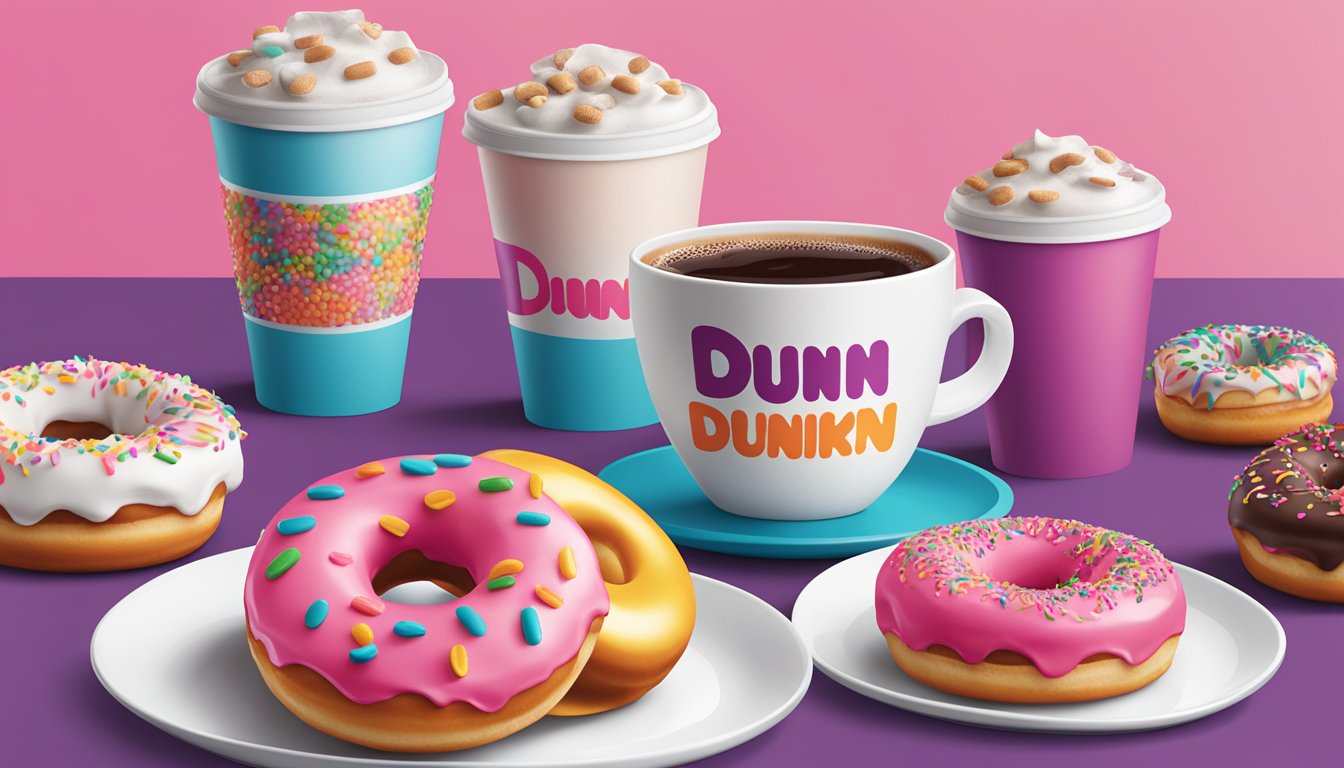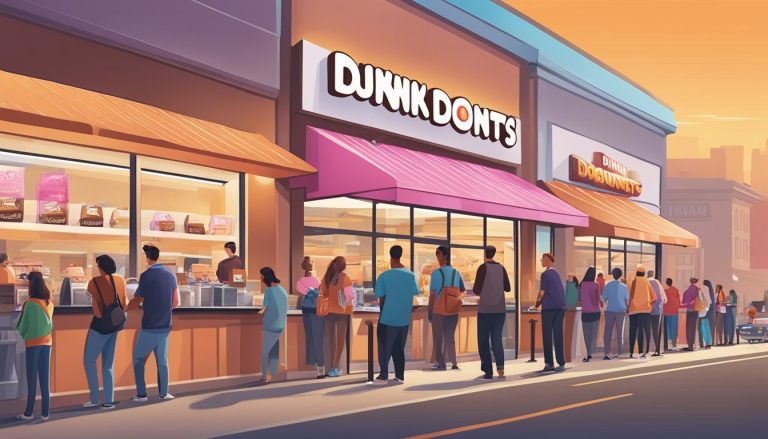Dunkin’ strategically employs limited-time offerings to create excitement and drive sales. These seasonal products tap into consumers’ desire for novelty and exclusivity, often sparking a sense of urgency to try something new before it disappears.
Limited-time offerings trigger psychological responses that motivate purchases, including fear of missing out (FOMO) and the perception of scarcity. When customers see a product is only available for a short period, they’re more likely to act quickly to avoid regret. This strategy aligns with broader retail trends, where brands leverage seasonal items to boost engagement and sales.
Dunkin’ combines these psychological triggers with loyalty program incentives, offering bonus points or exclusive access to limited-time items for rewards members. This approach not only encourages immediate purchases but also fosters long-term customer relationships, as patrons anticipate future special releases and promotions.
Understanding Dunkin’s Brand Identity
Dunkin’ has undergone significant changes to its brand identity over the years, evolving from a donut-focused chain to a beverage-centric destination. This shift reflects changing consumer preferences and market trends.
The Evolution of Dunkin’
Dunkin’ began as Dunkin’ Donuts in 1950, focusing primarily on donuts and coffee. Over time, the brand expanded its menu offerings to include a wider range of food and beverage options.
In 2018, Dunkin’ Donuts officially rebranded to simply “Dunkin'”. This change aimed to reflect the company’s broader focus beyond just donuts.
The rebranding effort included updating store designs, packaging, and marketing materials. Dunkin’ retained its iconic pink and orange color scheme, maintaining brand recognition while signaling a new direction.
This evolution demonstrates Dunkin’s adaptability and commitment to meeting changing consumer needs. The simplified name also aligns with modern branding trends favoring concise, memorable identities.
Dunkin’ as a Coffee Destination
Dunkin’ has strategically positioned itself as a coffee destination, competing directly with other major coffee chains. This shift aligns with consumer trends favoring coffee consumption.
Beverages now account for approximately 60% of Dunkin’s sales, highlighting the success of this strategic pivot. The company has expanded its coffee menu to include a variety of hot and cold options, catering to diverse tastes.
Dunkin’ emphasizes speed and convenience in its coffee service, appealing to on-the-go consumers. The brand’s marketing often focuses on its coffee offerings, reinforcing its identity as a coffee destination.
This focus on coffee has helped Dunkin’ maintain brand loyalty while attracting new customers seeking quality, affordable coffee options. The shift has solidified Dunkin’s position in the competitive coffee market.
Dunkin’s Marketing Strategies
Dunkin’ employs a multi-faceted approach to marketing, combining digital innovation with traditional methods to reach and engage customers. Their strategies focus on audience targeting, leveraging online platforms, and maintaining a strong presence through conventional advertising channels.
Targeting the Right Audience
Dunkin’ meticulously segments its market to appeal to diverse consumer groups. They tailor their offerings to meet the preferences of different demographics, from busy professionals seeking quick breakfast options to families looking for affordable treats.
The brand’s menu diversity reflects this strategy, with a range of products catering to various tastes and dietary needs. Dunkin’ also uses data analytics to understand customer behavior and preferences, allowing for more personalized marketing efforts.
Loyalty programs play a crucial role in Dunkin’s targeting strategy. These programs incentivize repeat visits and provide valuable customer insights for future campaigns.
Leveraging Digital Marketing
Dunkin’ has embraced digital platforms to enhance its marketing reach. Their mobile app serves as a cornerstone of their digital strategy, offering convenient ordering, payments, and exclusive deals to users.
Social media campaigns are another key component. Dunkin’ maintains an active presence on platforms like Instagram and Twitter, engaging customers with visually appealing content and interactive promotions.
Email marketing is utilized to deliver targeted messages about new products, limited-time offers, and promotions directly to customers’ inboxes. This approach helps maintain customer engagement and drives foot traffic to stores.
The Role of Traditional Advertising
Despite the shift towards digital, Dunkin’ continues to invest in traditional advertising methods. Television commercials remain a significant part of their strategy, often featuring catchy slogans and memorable jingles to reinforce brand recognition.
Print advertisements in newspapers and magazines help Dunkin’ reach audiences who may not be as active online. These ads often highlight seasonal offerings or new menu items.
Outdoor advertising, including billboards and signage, plays a crucial role in local marketing efforts. These visual reminders help keep Dunkin’ top-of-mind for potential customers passing by.
Product Offerings and Innovations

Dunkin’ leverages a dynamic approach to its menu, balancing classic favorites with innovative limited-time offerings. This strategy keeps customers engaged while allowing the brand to test new products and respond to evolving consumer preferences.
Cultivating a Diverse Menu
Dunkin’ continually expands its product range beyond traditional donuts and coffee. The menu now includes breakfast sandwiches, wraps, and a variety of hot and cold beverages. Specialty drinks like the Dunkaccino and Cold Brew have become popular staples.
Dunkin’ also introduces unique donut flavors regularly. These range from classic options to more adventurous creations like maple bacon or cookie dough-filled varieties.
By diversifying its offerings, Dunkin’ caters to different tastes and dietary needs. This approach helps attract a wider customer base and encourages repeat visits.
Seasonal Offerings and Consumer Preferences
Dunkin’ capitalizes on seasonal trends with limited-time offerings. These products often align with holidays or specific times of the year.
Examples include:
- Pumpkin-flavored drinks and donuts in fall
- Peppermint mochas during winter holidays
- Fruity iced teas for summer refreshment
These seasonal items create anticipation and drive foot traffic. They also allow Dunkin’ to gauge customer interest in potential permanent menu additions.
Dunkin’ uses customer data and market research to inform its product development. This ensures new offerings resonate with consumer preferences and current food trends.
Incorporating Healthier Options
Recognizing the growing demand for healthier choices, Dunkin’ has expanded its menu to include more nutritious options. This shift aims to attract health-conscious consumers without alienating its core customer base.
Some healthier additions include:
- Egg white breakfast sandwiches
- Oatmeal bowls
- Veggie egg white wraps
- Reduced sugar and fat alternatives in beverages
Dunkin’ also provides nutrition information for its products, allowing customers to make informed choices. This transparency aligns with modern consumer expectations for ingredient awareness and healthier eating habits.
The Customer Experience at Dunkin’

Dunkin’ prioritizes convenience, speed, and personalized service to create a customer-centric experience. The brand leverages technology and streamlined operations to meet the evolving needs of its patrons.
Convenience and Service
Dunkin’ focuses on accessibility and quick service to cater to busy customers. With over 9,000 locations in the United States, Dunkin’ ensures that coffee and donuts are never far away. The brand’s emphasis on fast service allows customers to grab their favorites without long waits.
Dunkin’ offers a diverse menu of coffee, donuts, and breakfast items to suit various tastes. The company regularly introduces new and seasonal offerings to keep the menu fresh and exciting. This variety, combined with consistent quality, helps maintain customer interest and satisfaction.
Mobile Ordering and the Loyalty Program
The Dunkin’ mobile app enhances the customer experience through convenient ordering and rewards. Customers can place orders ahead of time, customize their drinks, and skip the line for pickup. This feature saves time and reduces friction in the ordering process.
DD Perks, Dunkin’s loyalty program, incentivizes repeat visits. Members earn points on purchases, which can be redeemed for free beverages. The program also provides exclusive offers and early access to new menu items. These perks create a sense of value and encourage customer retention.
Dunkin’ Drive-Thru Efficiency
Drive-thru service is a key component of Dunkin’s convenience strategy. The company has invested in optimizing drive-thru operations to reduce wait times and improve order accuracy. Many locations feature digital menu boards and multiple ordering lanes to streamline the process.
Dunkin’ has also implemented contactless payment options at drive-thrus, catering to customers who prefer touch-free transactions. This addition enhances safety and speeds up service. The efficiency of Dunkin’s drive-thru operations contributes significantly to customer satisfaction, especially for on-the-go patrons.
Dunkin’s Competitive Landscape

Dunkin’ operates in a highly competitive quick-service restaurant market. The company faces strong rivalry from other major coffee and breakfast chains, particularly Starbucks. Dunkin’s market positioning focuses on affordability and convenience to differentiate itself.
Comparison with Starbucks
Dunkin’ and Starbucks take different approaches in the coffee market. Dunkin’ emphasizes speed and value, offering quality coffee at lower prices. Starbucks, in contrast, focuses on creating a premium coffee experience.
Dunkin’ attracts budget-conscious consumers with its competitive pricing. The chain’s menu includes a wide variety of coffee drinks, donuts, and breakfast items. Starbucks, however, targets customers willing to pay more for specialty coffee beverages and a café atmosphere.
Both chains have loyalty programs, but Dunkin’s rewards system is simpler and more focused on immediate discounts. This aligns with its value-oriented customer base.
Understanding Dunkin’s Market Positioning
Dunkin’ positions itself as an affordable, convenient option for coffee and quick meals. The brand’s slogan “America Runs on Dunkin'” emphasizes its role in customers’ daily routines.
The company’s strategy includes:
- Offering a diverse menu with frequent limited-time items
- Maintaining lower prices compared to premium coffee shops
- Focusing on fast service and drive-thru efficiency
Dunkin’ targets busy professionals, families, and anyone seeking a quick, satisfying breakfast or coffee fix. This positioning helps Dunkin’ compete effectively against both high-end coffee shops and fast-food chains entering the breakfast market.
To maintain its market position, Dunkin’ continuously innovates its menu and improves its digital ordering capabilities. These efforts aim to keep the brand relevant and convenient for its core customer base.
Promotional Strategies and Customer Engagement

Dunkin’ employs strategic promotional tactics and customer engagement initiatives to drive sales and foster brand loyalty. These efforts center on creating excitement through limited-time offers and building lasting connections with customers.
Limited-Time Offers and Promotions
Dunkin’ regularly introduces limited-time flavors and seasonal offerings to generate buzz and attract customers. These promotions often feature unique beverage and food pairings that align with current trends or holidays. For example, the brand might launch a Pumpkin Spice latte in autumn or collaborate with popular snack brands for special menu items.
Limited-time offers create a sense of urgency, encouraging customers to visit stores more frequently. Dunkin’ promotes these items through various channels, including social media, mobile apps, and in-store displays. The brand may also offer discounts or rewards points for trying new products, further incentivizing purchases.
Building Customer Loyalty Through Engagement
Dunkin’ focuses on cultivating strong customer relationships through its DD Perks loyalty program. Members earn points on purchases, which can be redeemed for free beverages. The program also provides personalized offers and early access to new products.
The brand leverages social media platforms to connect with customers, share promotions, and gather feedback. Dunkin’ encourages user-generated content by reposting customer photos and running hashtag campaigns. This strategy fosters a sense of community among Dunkin’ fans.
Dunkin’ also engages in local community initiatives, such as sponsoring events or partnering with charities. These efforts help build positive brand associations and strengthen customer loyalty beyond product offerings.
Price Strategy and Value Proposition

Dunkin’ employs a strategic pricing approach that balances affordability with perceived quality. This strategy aims to attract price-sensitive customers while maintaining a competitive edge in the quick-service restaurant industry.
Balancing Affordability with Quality
Dunkin’ positions itself as an accessible brand offering quality products at reasonable prices. The company’s value proposition centers on providing freshly-made coffee and baked goods quickly and conveniently. Dunkin’ keeps prices competitive by optimizing its supply chain and leveraging economies of scale.
To enhance perceived value, Dunkin’ frequently introduces limited-time offerings at slightly higher price points. These special items create excitement and justify premium pricing, allowing Dunkin’ to test customer willingness to pay for novel products.
Loyalty programs and combo deals further reinforce the brand’s value proposition. These initiatives reward frequent customers and encourage larger purchases, increasing overall sales volume while maintaining the perception of affordability.
Pricing Strategy Across the Menu
Dunkin’ implements a tiered pricing structure across its menu. Core items like coffee and donuts are priced competitively to drive foot traffic and maintain market share. Premium beverages and specialty food items command higher prices, capitalizing on customers seeking indulgence or variety.
The brand uses psychological pricing techniques, such as setting prices just below round numbers (e.g., $3.99 instead of $4.00). This strategy makes prices appear lower than they are, influencing purchase decisions.
Seasonal promotions and limited-time offers often feature slight price increases. These temporary adjustments allow Dunkin’ to gauge price elasticity and maximize revenue during peak demand periods without alienating budget-conscious customers.
By carefully balancing its pricing across different product categories, Dunkin’ maintains its image as an affordable option while strategically capturing additional value where possible.
Dunkin’ and the Community

Dunkin’ actively engages with communities through charitable initiatives and social responsibility programs. The company’s efforts span both local and global scales, focusing on fostering positive change and supporting various causes.
Corporate Social Responsibility
Dunkin’ demonstrates its commitment to social responsibility through several key initiatives. The company has implemented sustainable sourcing practices for its coffee beans, partnering with organizations to support farmers and promote environmental conservation. Dunkin’ has also taken steps to reduce its environmental impact by transitioning to recyclable packaging materials and energy-efficient store designs.
In response to customer preferences, Dunkin’ has expanded its menu to include healthier options and cater to diverse dietary needs. This includes offering plant-based alternatives and reducing artificial ingredients in their products. The company’s dedication to food safety and quality is evident in its rigorous standards and regular audits of suppliers and franchisees.
Local and Global Charity Initiatives
Dunkin’ actively supports communities through various charitable programs. The Dunkin’ Joy in Childhood Foundation focuses on improving children’s health and alleviating hunger. This foundation has donated millions of dollars to local food banks, children’s hospitals, and other nonprofit organizations.
On a global scale, Dunkin’ collaborates with international relief organizations to provide aid during natural disasters and crises. The company also adapts its charitable efforts to address specific needs in different regions where it operates. For instance, in some countries, Dunkin’ partners with local schools to improve educational facilities and provide resources for students.
Dunkin’ encourages employee volunteerism and often matches donations made by its staff. This approach fosters a culture of giving back within the company and strengthens its ties to local communities.
Analyzing Dunkin’s Target Market

Dunkin’ Donuts caters to a diverse customer base with targeted marketing strategies. The brand’s appeal spans various age groups and demographics, with a particular focus on younger consumers.
Demographics and Psychographics
Dunkin’ attracts customers from various walks of life. The core demographic includes working professionals, students, and families seeking affordable, convenient food and beverage options. Dunkin’s target audience values quick service, consistent quality, and affordable pricing.
Income levels of Dunkin’ customers range from low to middle-class. The brand’s accessibility and value proposition resonate with budget-conscious consumers. Geographically, Dunkin’ has a strong presence in urban and suburban areas, particularly in the northeastern United States.
Psychographically, Dunkin’ appeals to on-the-go individuals who prioritize convenience and familiarity. These customers often have busy lifestyles and appreciate the brand’s reliability and efficiency.
Appealing to Millennials and Gen Z
Dunkin’ has made significant efforts to attract younger consumers, particularly millennials and Gen Z. The brand has adapted its menu offerings to align with changing consumer preferences, introducing healthier options and trendy flavors.
Social media plays a crucial role in Dunkin’s strategy to engage younger audiences. The company leverages platforms like Instagram and TikTok to showcase limited-time offerings and create buzz around new products.
Dunkin’ also emphasizes customization options, allowing younger consumers to personalize their orders. This approach caters to the desire for unique experiences and self-expression among millennials and Gen Z.
Mobile ordering and loyalty programs further enhance Dunkin’s appeal to tech-savvy younger customers. These digital initiatives provide convenience and rewards, fostering brand loyalty among this demographic.
The Role of Technology in Dunkin’s Growth

Technology plays a pivotal role in Dunkin’s expansion and customer engagement strategies. Digital innovations have transformed how the brand interacts with consumers and streamlines operations.
Enhancing the Digital Experience
Dunkin’ has invested heavily in its digital presence to meet evolving customer expectations. The company’s mobile app serves as a central hub for customer engagement, offering features like mobile ordering and contactless payment options. This digital platform allows customers to browse menu items, customize orders, and skip lines by pre-ordering.
Dunkin’s rewards program, integrated into the app, incentivizes repeat visits and fosters brand loyalty. The app also provides personalized offers based on customer preferences and purchase history, enhancing the overall user experience.
The Impact of Mobile Technology
Mobile technology has revolutionized Dunkin’s operations and customer service. The introduction of mobile ordering has significantly reduced wait times and improved order accuracy. Customers can place orders in advance, specify pickup times, and pay through their smartphones.
Dunkin’ has also leveraged mobile technology for targeted marketing campaigns. Push notifications and location-based services allow the brand to send timely promotions and alerts to nearby customers. This approach has proven effective in driving foot traffic and increasing sales during slower periods.
Strategic partnerships with food delivery platforms have further expanded Dunkin’s reach, catering to customers who prefer home delivery. These collaborations have opened new revenue streams and broadened the brand’s customer base.
Expanding Dunkin’s Global Presence

Dunkin’ has successfully expanded its brand internationally through strategic market entry and localized offerings. The company’s global growth focuses on adapting to regional tastes while maintaining core brand elements.
Strategies for International Markets
Dunkin’ operates over 13,200 outlets across 42 countries, showcasing its strong global presence. The company leverages its brand recognition to enter new markets, particularly in Asia and Latin America where coffee consumption is rising. Dunkin’ carefully selects franchise partners with local market knowledge to facilitate smooth entry and operations.
Key expansion tactics include:
- Thorough market research to identify consumer preferences
- Adapting store designs to fit local aesthetics
- Tailoring marketing campaigns to resonate with regional cultures
- Investing in staff training to ensure consistent service quality
Localizing Offerings to Suit Regional Tastes
Dunkin’ recognizes the importance of catering to local palates while maintaining its brand identity. The company modifies its menu to include region-specific items alongside classic offerings. This approach helps Dunkin’ attract local customers and compete effectively with established local brands.
Examples of localized offerings:
- India: Saffron-pistachio doughnuts
- China: Green tea flavored products
- Netherlands: Stroopwafel-inspired doughnuts
Dunkin’ also adjusts portion sizes, pricing, and packaging to align with local norms and expectations. This flexibility in product development and marketing has been crucial to Dunkin’s success in diverse international markets.
Highlighting the Importance of Sustainability

Dunkin’ has embraced sustainability as a core value, implementing initiatives that benefit the environment and appeal to eco-conscious consumers. These efforts span packaging improvements, responsible sourcing, and product offerings.
Environmental Initiatives and Sustainable Practices
Dunkin’ has made significant strides in improving its packaging sustainability. 100% of their packaging is recyclable where facilities exist. Additionally, 30% contains recycled content, 35% is compostable, and 30% is biodegradable. These improvements demonstrate Dunkin’s commitment to reducing environmental impact.
The company has also focused on responsible sourcing. In 2015, Dunkin’ introduced a limited-time offering of 30% Rainforest Alliance Certified Colombian Packaged Coffee. This single-origin coffee highlighted their dedication to sustainable farming practices.
Internationally, Baskin-Robbins launched limited-time sorbet flavors using 50% Rainforest Alliance Certified tea. These products showcase the brands’ efforts to incorporate sustainability into their menu offerings.
Dunkin’ Brands’ sustainability report outlines their progress in creating positive change for customers and communities worldwide. The company focuses on three key areas: food, restaurants, and communities. This comprehensive approach underscores their commitment to sustainability across all aspects of their business.




